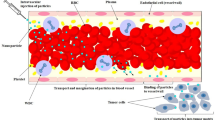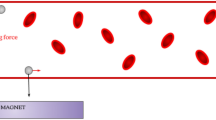Abstract
Various nanoparticles have been developed as imaging probes and drug carriers, and their selectivity in binding to target cells determines the efficacy of these functionalized nanoparticles. Since target cells in different arterial segments experience different hemodynamic environments, we study the effects of wall shear rate waveforms on particle binding. We also explore the effects of the kinetic rate constant, which is determined by particle design parameters, on particle binding. A transport and reaction model is used to evaluate nanoparticle binding to the substrate in a laminar flow chamber. Flow and particle concentration fields are solved by using a computational fluid dynamics. The particle binding rate increases as the mean value of wall shear increases, and the amplitudes of sinusoidal shear waveform do not affect the bound particle density profiles significantly. Particle binding rates increase with the rate constant of attachment (k A), and are more sensitively affected by low k A values and less by k A values higher than 1 × 10−6 m s−1. Since binding selectivity is affected by k A and the wall shear rate, the results of this study can be used for designing functionalized nanoparticles targeting for the specific cells that experience a specific shear rate.






Similar content being viewed by others
References
Affeld K, Reininger AJ, Gadischke J, Grunert K, Schmidt S, Tiele F (1995) Fluid mechanics of stagnation point flow chamber and its platelet deposition. Artif Organs 17:597–602
Alon R, Hammer DA, Springer TA (1995) Lifetime of the P-selectin-carbohydrate bond and its response to tensile force in hydrodynamic flow. Nature 374:539–542
Bell GI (1978) Models for the specific adhesion of cells to cells. Science 200:618–627
Bell GI, Dembo M, Bongard P (1984) Cell adhesion: competition between nonspecific repulsion and specific bonding. Biophys J 45:1051–1064
Chang HN, Robertson CR (1976) Platelet aggregation by laminar shear and Brownian motion. Ann Biomed Eng 4:151–183
Chappell DC, Varner SE, Nerem RM, Medford RM, Alexander RW (1998) Oscillatory shear stress stimulates adhesion molecule expression in cultured human endothelium. Circ Res 82:532–539
Charoenphol P, Huang RB, Eniola-Adefeso O (2010) Potential role of size and hemodynamics in the efficacy of vascular-targeted spherical drug carriers. Biomaterials 21:1392–1402
Cozens-Roberts C, Lauffenburger DA, Quinn JA (1990) Receptor mediated cell attachment and detachment kinetics. Biophys J 58:841–856
Dai G, Kaazempur-Mofrad MR, Natarajan S, Zhang Y, Vaughn S, Blackman BR, Kamm RD, Garcia-Cardena G, Gimbrone MA Jr (2004) Distinct endothelial phenotypes evoked by arterial waveforms derived from atherosclerosis-susceptible and -resistant regions of human vasculature. Pro Natl Acad Sci USA 101:14871–14876
David T, Thomas S, Walker PG (2001) Platelet deposition in stagnation point flow: an analytical and computational simulation. Med Eng Phys 23:299–312
Decuzzi P, Ferrari M (2008) Design maps for nanoparticles targeting the diseased microvasculature. Biomaterials 29:377–384
Decuzzi P, Lee S, Decuzzi M, Ferrari M (2004) Adhesion of microfabricated particles on vascular endothelium: a parametric analysis. Ann Biomed Eng 32:793–802
Dustin ML, Springer TA (1998) Lymphocyte function-associated antigen-1(LFA-1) interaction with intracellular adhesion molecule-1(ICAM-1) is one of at least three mechanisms for lymphocyte adhesion to cultured endothelial cells. J Cell Biol 107:321–331
Eckstein EC, Tilles AW, Millero F Jr (1988) Conditions for the occurrence of large near-wall excess of small particles during blood flow. Microvasc Res 36:31–39
Ganghoffer J-F, Kabouya N, Mefti N (2010) A stochastic model of cell aggregation under planar flow in the dilute regime. J Biomech 43:248–253
Goldsmith HL, Marlow JC (1979) Flow behavior of erythrocytes. II. Particle motions in concentrated suspensions of ghost cells. J Colloid Interface Sci 71:383–407
Haun JB, Hammer DA (2008) Quantifying nanoparticle adhesion mediated by specific molecular interactions. Langmuir 24:8821–8832
Hentzen ER, Neelamegham SN, Kansas GS, Benanti JA, MaIntire BLV, Smith CW, Simon SI (2000) Sequential binding of CD11a/CD18 and CD11b/CD18 defines neutrophil capture and stable adhesion to intracellular adhesion molecule-1. Blood 95:911–920
Hinds TM, Park YJ, Jones SA, Giddens DP, Alevriadou BR (2001) Local hemodynamics affect monocytic cell adhesion to a three dimensional flow model coated with E-selectin. J Biomech 34:95–103
Huang PY, Hellums JD (1993) Aggregation and disaggregation kinetics of human blood platelets. Biophys J 65:334–343
King MR, Hammer DA (2001) Multiparticle adhesive dynamics: hydrodynamic recruitment of rolling leukocytes. Pro Natl Acad Sci USA 98:14919–14924
Lim CT, Han J, Guck J, Espinosa H (2010) Micro and nanotechnology for biological and biomedical applications. Med Biol Eng Compt 48:941–943
Longest PL, Kleinstreuer C (2003) Comparison of blood particle deposition models for non-parallel flow domains. J Biomech 36:421–430
Lyczkowski RW, Alevriadou BR, Horner M, Panchal CH, Shroff SG (2009) Application of multiphase computational fluid dynamics to analyze monocyte adhesion. Ann Biomed Eng 37:1516–1533
Munn LL, Melder RJ, Jain RK (1996) Role of erythrocytes in leukocyte-endothelial interactions: mathematical model and experimental validation. Biophys J 71:466–478
Muro S, Dziubla T, Qiu W, Leferovich J, Cui X, Berk E, Muzykantov VR (2006) Endothelial targeting of high-affinity multivalent polymer nanocarriers directed to intercellular adhesion molecule 1. J Pharm Exp Ther 317:1161–1169
Nam JM, Thaxton CS, Mirkin CA (2003) Nanoparticle based bio-bar codes for the ultrasensitive detection of proteins. Science 301:1884–1886
Piper JW, Swerlick RA, Ahu C (1998) Determining force dependence of two-dimensional receptor-ligand binding affinity by centrifugation. Biophys J 74:492–513
Tandon P, Diamond SL (1997) Hydrodynamic effects and receptor interactions of platelets and their aggregates in linear shear flow. Biophys J 73:2819–2835
Tees DFJ, Goetz DJ (2003) Leukocyte adhesion: an exquisite balance of hydrodynamic and molecular forces. News Physiol Sci 18:186–190
Tsapis N, Bennett D, Jackson B, Weitz DA, Edward DA (2002) Trojan particles: large porous carriers of nanoparticles for drug delivery. Pro Natl Acad Sci USA 99:12001–12005
Turrito V, Baumartner (1975) Platelet interaction with subendothelium in a perfusion system. Microvasc Res 9:335–344
Weissleder R, Kelly K, Sun EY, Shtatland T, Josephson L (2005) Cell-specific targeting of nanoparticles by multivalent attachment of small molecules. Nat Biotechnol 23:1418–1423
Whitesides GM (2003) The ‘right’ size in nanotechnology. Nat Biotechnol 21:1161–1165
Acknowledgment
This work is supported by the Fundamental Research Supporting Program (2009-0070812) of National Research Foundation of Korea.
Author information
Authors and Affiliations
Corresponding author
Rights and permissions
About this article
Cite this article
Kim, M.J., Rhee, K. Computational analysis of nanoparticle adhesion to endothelium: effects of kinetic rate constants and wall shear rates. Med Biol Eng Comput 49, 733–741 (2011). https://doi.org/10.1007/s11517-011-0735-1
Received:
Accepted:
Published:
Issue Date:
DOI: https://doi.org/10.1007/s11517-011-0735-1




